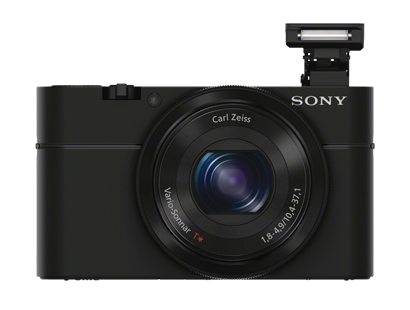
Sony's Cyber-shot DSC-RX100 is tiny when its capabilities are considered. It has a 1.0-inch, 20.2 megapixel imaging sensor crammed into a compact 4-inch by 2 3/8-inch by 1 7/16-inch body which weighs 7.5 ounces. The lens is a Carl Zeiss® Vario-Sonnar T* with a 35 mm equivalent focal length of 28-100 mm. The lens can be zoomed either by using the rocker around the shutter button or by using the control ring around the lens barrel - something I find far more precise.
A little about my camera choices: I'm a longtime SLR owner - my first was a Minolta Maxxum 9000 analog SLR in 1985. Though I'm firmly on the consumer side of the prosumer divide (unlike the notable skill sets of some others at Mac Edition Radio!), I owned a series of three more Maxxum analog SLRs before going digital: transitioning first to a Nikon D70 and than my current Nikon D90.
In addition, I have owned a series of digital point and shoots, starting with a lovely, jewel-like Canon PowerShot Digital ELPH S100 in 2000 (all of 2.0 megapixels!), and moving through a Minolta DiMAGE F100 before ending up with a Canon PowerShot Digital ELPH SD1000. It is that final Canon that was found wanting on a vacation late last year with the classic point and shoot issues of slow response, small sensor, and restricted file format options. This led me (eventually and after much consideration) to the RX100, which was purchased in March 2013.
Sony calls it a "professional compact digital camera", and the Cyber-shot DSC-RX100 certainly has many features and capabilities. In fact it is so full-featured (and the Sony guide that comes with the camera is so limited) that I gained significant value from the Kindle version of Alexander White's Photographer’s Guide to the Sony DSC-RX100.
The RX100 gives an SLR owner a lot of familiar features. You can shoot RAW and there are many flexible program modes along with customizable function menu. There's also a standard tripod mound.
Some things are missing: there is no hotshoe (not a significant issue for me) and no optical viewfinder (definitely an adjustment). The thinness of the camera also means that the LCD display is fixed. There is no built-in WiFi or GPS, but Eye-Fi cards are supported. Finally, there is no "stock" way to attach an optical filter, though there are third-party glue-on options.
I have been consistently pleased and impressed with the RX100, a piece of electronics that shows that Sony retains considerable expertise in miniaturization. Shooting response is extremely quick - something many people using my RX100 have noticed. The Carl Zeiss lens is able to satisfy almost all of my needs and the picture quality has been excellent. The face detection is effective and useful and the sweep panorama feature works well with little effort required. The 3-inch "WhiteMagic" LCD display with its additional white dot added to the usual red, green, and blue is easily visible under almost all lighting conditions and the menus are reasonably intuitive. I find that Apple's Aperture handles the RX100's RAW files very well.
Downsides I have seen are few: first, the capabilities of the RX100 expose my propensity to shake small cameras - a problem that is not the RX100's fault but is an issue I don't have when using SLRs. Low light performance with the pop-up flash off is not nearly as good as the Nikon D90's, so I've had to adjust the way I shoot some subjects such as indoor live performances. Of course, there are the occasional times when I miss being able to switch lenses. I'm also not at all confident that the tiny door on the bottom of the camera that allows access to the battery and memory card will last as long as the rest of the camera.
In conclusion, and most importantly, I find the RX100 to be genuinely "pocketable". It fits easily into a jacket pocket (it fits in a shirt pocket but feels very heavy). This is its most important feature: near SLR capability in something that I can easily take almost anywhere.
John Mulhern III, Posted 8/11/13
Photograph of Mount Cook in Alaska Copyright © John Mulhern III 2013
For more information on the Sony Cyber-shot DSC-RX100 visit: www.sony.com



